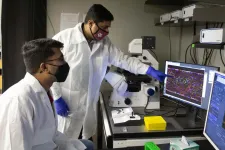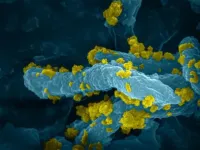(Press-News.org) Sickle cell disease is the most prevalent inherited blood disorder in the world, affecting 70,000 to 100,000 Americans. However, it is considered an orphan disease, meaning it impacts less than 200,000 people nationally, and is therefore underrepresented in therapeutic research.
A team led by Abhishek Jain from the Department of Biomedical Engineering at Texas A&M University is working to address this disease.
"I'm trying to create these new types of disease models that can impact health care, with the long-term goal of emphasizing on applying these tools and technologies to lower health care costs," said Jain, assistant professor in the department. "We strategically wanted to pick up those disease systems which fall under the radar in orphan disease category."
Jain's research is in organ-on-a-chip, where cells from humans can be grown on USB-sized devices to mimic the way the organ would work inside the body. This sort of system is ideal for testing new drug treatments, as drugs cannot be tested on humans, and animal models have not shown to be a good representation of how a patient and disease would interact with a treatment. For sickle cell disease patients, the organ-on-a-chip would also be beneficial because patients can present with mild to severe cases.
Jain works with Tanmay Mathur, a fourth-year doctoral student who trained as a chemical engineer in his undergraduate years. His research focused on microfabrication techniques and simulations, skills he said merged well into the organ-on-a-chip research he now performs in Jain's lab. The team collaborates closely with the Texas Medical Center in Houston.
The work was recently published in the journal Bioengineering & Translational Medicine. Their paper builds off a 2019 publication in the journal Lab on Chip, where the team demonstrated that endothelial cells (cells that line the blood vessels) could be used to model the disease physiology of a patient without having to stimulate the model to perform differently than a healthy vessel.
"Traditionally these cells were not used for disease modeling, so in that way our approach is very novel," Mathur said. "We are one of first to harness these cells and employed them in disease modeling research."
Mathur and Jain demonstrate that these models can be used to differentiate between patients. The first step: build a blood vessel that mimics a patient's vessel. For that the team would need two components -- patient blood and endothelial cells. Collecting the blood involved a simple blood draw. They faced a challenge with the endothelial cells, however. They would need to take a biopsy of the cells or use stem cells to grow their own, neither of which was ideal.
Then they found the answer was in the blood.
"What we learned is within blood samples are some endothelial cells also circulating," Jain said. "We call them blood outgrowth endothelial cells that we can harness very easily. That's what is new about this work. You can get those cells, grow them so that's there's enough in number and then you can make blood vessels."
Now that they could build the vessels, the next step was to see if these models would show how the disease has various biological impacts in different patients. Again, the goal was to be able to test treatments on these models, so the closer they mimiced their human patient, the better.
"We're able to differentiate a very severe sickle cell patient in terms of their phenotype from very mild patients," Mathur said. "Moving forward, we can take a larger population of any sickle cell disease patients and assess them using our organ-chip technology and then categorize them into different groups based on symptoms."
Their findings indicate that these organs-on-a-chip could lead to patient-centric, personalized treatment, improving how clinicians approach this and other cardiovascular diseases.
"When you take it to the field, now it can become a predictive device," Jain said. "Now you do not have to know whether the patient is mild or severe, you can test for that. You can predict if patient is serious and can dictate their therapeutic needs."
The next step is to continue to expand the patient cohort to collect more results. A long-term goal would be to use the patient information collected to develop a database to better predict disease progression.
"You take a history of a lot of these patients and their cardiovascular health with this device, and you can predict which patient might have better chance of having a stroke and you start treating them early on," Jain said.
Mathur said even with future challenges, he looks forward to continuing their research.
"I think even though it may take 10, 15 years, we will at least push forward some of the research that we're doing and get it out in the clinical field," he said. "We are one of the only groups in the world that have started this field of personalized treatment. I feel that our impact is pretty high, and I'm sure we will be able to expand the same treatment to other cardiovascular diseases and attract more attention and deeper insights into the biology that we are looking at."
INFORMATION:
This work is funded by a Trailblazer Award Jain received from the National Institute of Biomedical Imaging and Bioengineering.
>
CATONSVILLE, MD, March 24, 2021 - COVID-19 has been shown to spread on airplanes by infected passengers, so minimizing the risk of secondary infections aboard aircraft may save lives. New research in the INFORMS journal Service Science uses two models to help solve the airplane seating assignment problem (ASAP). The models can lower the transmission risk of COVID-19 more so than the strategy of blocking the middle seats, given the same number of passengers.
"Blocking the middle seat on an airplane may provide limited benefit in reducing the risk of transmission of COVID-19. Rather, other health protocols are better supported at preventing the transmission ...
SARS-CoV-2, the virus responsible for the COVID-19 pandemic, arrived one year ago and turned our lives upside-down.
While worldwide vaccination programs are currently ongoing, we do not yet know for how long the vaccine will provide immune protection against infection, and if the currently approved vaccines can provide protection against the emerging virus variants.
In addition, it appears that vaccines cannot prevent illness for people who have already been infected. In contrast to vaccines, there are currently no effective drugs that act against the virus SARS-CoV-2.
New research by Associate Professor Jasmin Mecinovic and co-workers from the Department of Physics, Chemistry and Pharmacy, University of Southern Denmark, now presents a compound that might provide a basis for the ...
Decarbonizing the economy and achieving the transition from fossil fuels to renewable energies is one of the most urgent global challenges of the 21st century. Hydrogen can play a key role in this process as a promising climate-neutral energy vehicle. Yet, the so-called green hydrogen economy requires that hydrogen production be based exclusively on renewable energy. In addition, it should ideally not use expensive and rare metal catalysts, whose production has severe environmental consequences. To address this challenge, ITQB NOVA researchers Inês Cardoso Pereira and Mónica Martins are working on an innovative technology to produce hydrogen from light using non-photosynthetic microorganisms.
Hydrogen offers exciting new possibilities as an energy vehicle, ...
The Event Horizon Telescope (EHT) collaboration, a multinational team of over 300 scientists including two astrophysicists from the University of the Witwatersrand (Wits University), has revealed today a new view of the massive object at the centre of the M87 galaxy: how it looks in polarised light.
This is the first time astronomers have been able to measure polarisation, a signature of magnetic fields, this close to the edge of a black hole. The observations are key to explaining how the M87 galaxy, located 55 million light-years away, is able to launch energetic jets from its core.
"We are now seeing the next crucial piece of evidence to understand how magnetic fields behave around black holes, and how activity in this very compact region of space can drive powerful ...
The Event Horizon Telescope (EHT) collaboration, who produced the first ever image of a black hole, has today revealed a new view of the massive object at the centre of the Messier 87 (M87) galaxy: how it looks in polarised light. This is the first time astronomers have been able to measure polarisation, a signature of magnetic fields, this close to the edge of a black hole. The observations are key to explaining how the M87 galaxy, located 55 million light-years away, is able to launch energetic jets from its core.
"We are now seeing the next crucial piece of evidence to understand ...
A new study from the University of Bergen (UiB) shows that the way young people view their bodies have a great impact on their BMI.
In a two-year follow up study among 1225 Norwegian adolescents in their early teens, professor Eivind Meland and his team examined how body mass index, self-esteem and self-rated health were mutually impacted and influenced by body dissatisfaction.
"We revealed that positive self-image and self-esteem protected against weight gain", professor emeritus Meland says.
The girls had in general lower body confidence than boys, the study shows.
Body dissatisfaction
The eager to be thinner, dieting, and wanting to change something with the body all impaired self-rated health ...
A new study shows that when people replace their old couch with a new one that has no added flame retardants, levels of the harmful chemicals in household dust drop significantly. Replacing the foam inside the couch cushions is also just as effective. The findings confirm that choosing healthier furniture without flame retardants can make a big difference in people's--especially children's--everyday exposures to these toxic chemicals.
"We've long suspected that couches are a major source of toxic chemicals in dust. Now, for the first time, we have evidence demonstrating the positive impacts of replacing old furniture containing flame retardants," ...
What is the world made of? This question, which goes back millennia, was revisited by theoretical physicist Steven Weinberg from the University of Texas in Austin, TX, USA in the first of an international seminar series, 'All Things EFT'. Weinberg's seminar has now been published as an article in the journal EPJ H.
And Weinberg is well placed to discuss both Effective Field Theories (EFTs) and the nature of the Universe, as he shared the 1979 Nobel Prize for Physics for developing a theory to unify the weak and electromagnetic interactions between elementary particles. This fed into the development of the ...
Ruptures of the carotid artery (cervical artery dissection) are the most common cause of stroke in people under 50 years of age, with an annual incidence of 2-3 cases per 100,000 persons. Salicylic-acid preparations (acetylsalicylic acid: aspirin, Aspegic) and blood-thinning medication (anticoagulants) are used for treatment. The multicenter therapy study "Biomarkers and Antithrombotic Treatment in Cervical Artery Dissection (TREAT-CAD, NCT02046460)" investigated whether dissections - tears in the wall of vessels supplying blood to the brain - can be treated with aspirin or whether more complex blood thinning (anticoagulation) ...
Copepods are tiny crustaceans about the size of a grain of rice, but they are one of the most important parts of the Earth's aquatic ecosystems. Their behavior and interaction with the environment, however, remains a relative mystery. Now, a recent paper published in the Journal of Experimental Biology sheds new light on how these miniature marvels move and cluster in the ocean.
Researchers from Bigelow Laboratory of Ocean Sciences and the Georgia Institute of Technology found that the copepods gather around small vortexes in the ocean, a finding which could have significant implications for the food web.
"We're getting at a mechanism that helps us understand how the ecosystem ...





